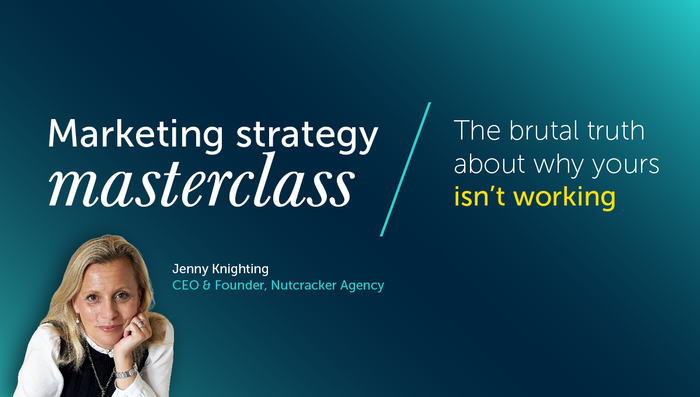Sales & Lead Generation
Going for growth? 6 barriers and how to break them
Anyone who’s grown a business knows the highs when things are looking up, and the lows that come when things don’t go so well. This month we are looking at sustainable growth — the ups and downs never go away, but when you’re more established as a business, growth is more complex. Every step forward comes with more overheads and more complexity — new customers and bigger orders can mean more investment, more upfront cost (and perhaps more debt), and more hires, all of which carry risk.
Then sometimes, growth doesn’t seem to be happening at all.
This is our guide to the six most common barriers to business growth, and how to overcome them sustainably.
The 1st growth barrier - bottlenecks
Perhaps there’s just one thing that’s holding back your growth — one blockage to clear.
Maybe it’s talent. You’ve got the ideas, the resources, and the market, but you don’t yet have the people who can make it happen.
Maybe it’s cost, and your margins are too tight to leave you anything to invest.
Maybe it’s time. You need to spend every hour you have just to keep the business where it is, never mind growing it.
Let’s say you have a small sales team. They’re brilliant, but they’re maxed out, and you won’t realistically get any more monthly deals from them. You can:
Hire more sales people
It’s great if you can do it, but it needs to be properly supported by your marketing efforts — hiring and training salespeople is expensive, the churn rate is often high, and salespeople work through contacts lists very quickly. Speaking of which …
Help your salespeople out with joined-up marketing
Many salespeople have to generate, nurture and close all of their leads. A more joined-up marketing approach could deliver them warm, engaged leads, who close far sooner. If your teams spend less time cold calling and more time closing warm prospects, they’ll bring in more business in the same amount of time.
Address customer retention
Keeping a customer is always cheaper than acquiring one, so what’s your retention rate, and what’s your retention strategy? Growing businesses can focus so much on new clients that they forget to work on keeping the ones they have.
The 2nd growth barrier - growth vs profit
Uber, Tesla, Spotify, Snapchat, Peloton —they’re not the most relatable companies, and when it comes to a lot of business rules, they’re exceptions. One thing they do illustrate is the pursuit of growth over profit.
Assuming you don’t have people throwing money at you as those companies do, you need to balance your growth with your profit.
The first question to ask is, where are you on the journey, and what’s the next goal? If you’re trying to grow your startup with a view to an exit, then profit might not matter too much. If your business is self-sustaining and you still want to grow, then it’s more of a balancing act.
Growth is always going to imply escalating overheads. Selling more? You need to deliver more. Need to deliver more? You need to hire more people. Hiring more people? You need a bigger office. That means, of course, that each step towards growth can hurt your profit margins, so you need to be very conscious of how sustainable your growth rate is.
Thinking about the bottlenecks from earlier, it might be that you can address one blocker and unlock huge growth. That’s great news from a profitability perspective, because that’s one small change that makes a huge difference. However, if growth requires more fundamental strategic action, then it may be that your growth might be slower than your ambition would like. Of course, slow and sustainable is always better than fast and unviable.
The 3rd growth barrier - firefighting
At times, it feels like building a business is dashing from one disaster to another. The good news is, that’s normal, so don’t feel like yours is a particular nightmare. The bad news is that those are not the conditions to grow a business. If you’re building a house, you won’t make much progress if you have to keep running to different rooms to put out fires.
Generally speaking, the newer your business is, the more fires there are going to be, and that’s particularly galling because its early days are exactly when your company needs to grow the most.
If you, as the founder and leader, are going to concentrate on growth, you have two options:
A) stop fires from starting
B) have someone else put them out
In many cases, you couldn’t have seen the crisis coming — if you had, you would have prevented it — but even if you can’t stop it the first time, you can stop it from happening again. As you’ll have seen first-hand, in business you learn most lessons the hard way.
The next step is to find somebody you can trust to put out fires for you. Letting go and allowing someone else to help look after even a small part of your business is incredibly difficult for a lot of founders, but it’s how you unlock your growth potential.
The 4th growth barrier - over-reliance on you
Speaking of letting go, it works the other way too. Lots of teams are used to coming to their founders for the answers, and at some point that has to stop.
At all sizes and ages of business, but especially in smaller and younger companies, the line where the founder ends and the business begins is blurry.
What can then happen, is that employees become accustomed to discussing every action and decision with you. Then, that is how newer team members behave, and a culture of dependence takes root.
Maybe all you need to do is tell your teams that they should work things out for themselves. It could be that all they needed was your permission. If they’re still reluctant to accept autonomy, you can always refuse to give them the answers until they’ve thought about things and tried solutions for themselves, and you can either withdraw your support gradually or ‘cold turkey’.
When you encourage risk and make it clear that any resulting failures are acceptable, you can build an environment in which your team feels safe to think and act for themselves. It takes preparation and time to change a culture — your teams need to be ready to take the reins, and demonstrate that ability, or you won’t be confident to hand them over.
The 5th growth barrier - competition, disruption and market shifts
Sometimes, a company’s growth suddenly stops, and refuses to pick up again. The possible reasons for that are close to infinite, but if it’s not due to something internal to the business, then the pressures are often from competitors or market conditions.
Maybe you were so used to being the disruptor that you didn’t think you might get disrupted, or you’ve been so focused on your own offering that you didn’t notice a new player arrive, or perhaps the market just changed, and what you offer isn’t in demand like it used to be. Here is where your marketing keeps your finger on the pulse of the market. As part of your digital strategy, things like competitor and market keyword analysis will reveal developments that you should be aware of.
No company can afford to be complacent, least of all one with ambition, and when you’ve identified what’s stunting your growth, you need to respond as soon as you possibly can. What that response should be is of course a huge question, and an enormous ‘it depends’, but here are a few companies that responded brilliantly to disruption, upheaval, or simply in response to results.
Shopify
Tobias Lükte and Scott Lake set up online snowboarding store Snowdevil in 2004. They didn’t like any of the available eCommerce software, so they built their own. Their business was successful enough, but what got more attention was the online retail platform they’d created. The founders decided to change their business focus entirely, and started selling their platform, which became Shopify, and which turned over US$4.6 billion in 2021.
In 2005, a start-up called Odeo was running a platform for discovering and subscribing to podcasts. Then, iTunes took over the market. The company had a brainstorming session to try and find a new direction. An employee named Jack Dorsey had the idea to build the platform around sharing thoughts and activities in a ‘status’. Twitter was born. After a lot of controversy, in 2022 Elon Musk agreed to buy it for US$44 billion.
Slack
Flickr co-founder Stewart Butterfield returned to his professional roots building games, founding Tiny Speck and producing a computer game called ‘Glitch’, which ultimately never showed much commercial promise.
However, Butterfield had wanted a team messaging platform while Tiny Speck were developing Glitch, but he didn’t like any existing products, so he built his own. Tiny Speck, now Slack, invited peers and friends in other companies to try out their new platform, which grew to 16,000 users through word of mouth.
It took just a year and a quarter to reach a US$1 billion valuation, and in May 2022, Slack’s market cap was US$26.51 billion.
Breaking down business growth barriers
You might not be on the same trajectory as some of the companies in this guide (they call them unicorns for a reason), but then you never know what potential there is to unlock. As the founder, you pour your whole self into your business — it’s your creation, your passion, and for many, it’s their whole world. If anything is holding it back, you won’t rest until you overcome it.
Nutcracker’s founder and CEO has been there many times with many businesses — she knows exactly how it feels, but she also knows what to do about it.
If you want to pick Jenny’s brain about how to unlock your growth, she’d love to have a coffee, so give us a call on 020 3941 0305 or drop her an email at jenny.knighting@nutcrackeragency.com.
Author Bio
Charles Scherer, Content Lead at Nutcracker Agency
Charles Scherer is the Content Lead at Nutcracker Agency, a B2B marketing firm with offices in Ipswich and London. With years of experience crafting compelling narratives for B2B brands, Charles specialises in creating content that not only tells a great story but also delivers measurable business outcomes.
His expertise lies in bridging the gap between creative public relations strategies and tangible results, helping brands secure valuable media coverage and build topical authority online. Charles's work demonstrates a deep understanding of what makes a brand's story resonate with both journalists and target audiences, making him a trusted voice in the field of B2B content and PR
Share this:







